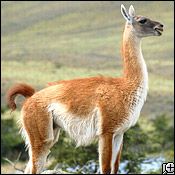Guanacos are usually found in small herds or loosely structured family groups.
When a member of the herd picks up the slightest hint of danger, it makes a high-pitched warning call, causing the other guanacos to flee swiftly and nimbly across the steep and uneven terrain.
Advertisement
Guanacos generally live at high elevations, grazing on grasses and browsing on leaves and buds.
They can get by without water for long periods of time, obtaining moisture from the plants they eat.
The young play and romp, but when confronted by an adult male they will lay their neck on the ground in submission.
The guanaco is one of the largest wild mammals in South America, and the puma is its only significant natural predator.
Classified as endangered in Chile and Peru, its numbers in Chile appear to be increasing.
Advertisement
